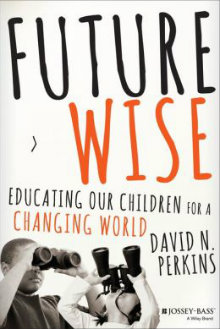Beyond Tech: Learning into the Future
Future Wise: Educating Our Children for a Changing World
By David N. Perkins
(Jossey-Bass, 2014 – Learn more)

The current edu-trend being promoted online is the Department of Education’s Future Ready Initiative. It asks superintendents to make a visible commitment to providing equitable access to digital tools and online resources for all students. The apparent thinking is, through sheer exposure to technology within the school walls, today’s learners will be ready for tomorrow’s unknown challenges.

Go to tweetdeck.com, a Twitter tool that allows you to read multiple feeds based on a search term. Create four columns, one listing tweets with the #futureready hashtag, and the others listing tweets containing the hashtags #ipaded, #byod, and #edtechchat.
What differences do you see between the #futureready tweets and the other tech-minded posts? From my observation, not much. This program appears to benefit technology providers and outside consultants as much as schools, teachers and students.
I’m not against technology in school; I can be as infatuated with these digital tools as anyone. But I am even more interested with how all school activities, not just those facilitated by software and hardware, might enhance our educational experiences today and make them memorable for years to come.
Lifeworthy Curriculum
David Perkin’s recent book Future Wise: Educating Our Children for a Changing World takes a similar approach. His previous work, Making Learning Whole, focused on instruction. Future Wise zeroes in on curriculum. Specifically, Perkins is interested in pursuing learning that is “lifeworthy.” What makes something lifeworthy? Consider this question he poses early on in the text: “What did you learn during your first twelve years of education that matters in your life today?” (p. 10)
He breaks lifeworthy learning pursuits out into six broad trends, what Perkins calls “the six beyonds”:
- Beyond basic skills – twenty-first-century skills and dispositions.
- Beyond the traditional disciplines – renewed, hybrid, and less familiar disciplines.
- Beyond discrete disciplines – interdisciplinary topics and problems.
- Beyond regional perspectives – global perspectives, problems, and studies.
- Beyond mastering content – learning to think about the world with the content.
- Beyond prescribed content – much more choice of what to learn. (2-3)
A Framework of Quests
Perkins delves more deeply into these trends throughout the book. He uses the concept of “quests” to address the six areas, asking the reader at the end of each chapter to identify, choose and teach lifeworthy learning, as well as to develop a lifeworthy curriculum. Perkins helps the reader identify big understandings, big questions, and big know-hows within the frame of these quests.
“My hope is that the pages may offer all of us a kind of tool kit: key concepts, criteria, and ways of prioritizing that will help us all arrive at better answers to what’s worth learning in our classes, our school systems, and our nations.” (5)
Yes, this involves jettisoning outdated and ineffective curriculum to make room for what matters in the lives of learners today and tomorrow. He refers to this as “smart sampling.” Smart sampling is not new to schools. “Any teacher of literature recognizes that a particular era or style contains far too many fine exemplars to cover. The teaching of literature always involves superselectivity.” (66) Perkins deems several areas of instruction as endangered species; for example, quadratic equations in mathematics and mitosis in biology.
When Perkins does address digital technologies, it is brief. He touches on what the Internet has accomplished regarding the explosion of knowledge via the Internet and the creation of a smaller world. Perkins states that this is only a beginning, emphasizing newer technologies and how they can support better student learning opportunities, such as virtual reality, social media for global perspectives, and mobile devices (118-120). Beyond this section, the book’s focus remains on the “what” of learning.
Structures for Learning
The remainder of the text explores the structures and frameworks that teachers can integrate into their instruction. Backward design, project-based learning, and concept-based instruction are all mentioned. However, Perkins doesn’t subscribe to one specific idea, but rather highlights many possibilities and allows the reader to determine what will serve his or her students best. As long as the teacher moves beyond “a sack full of facts” (166) and structures the learning around interesting and important subject matter and skills, students will most likely benefit from the instruction provided.
At first, I was a bit disappointed that the author was not more pointed in his opinion about certain programs and curriculum designs. After finishing the book, however, I did feel a sense of relief in not having to consider one framework and how it might fit within our school.
Perkins sticks to the concept of big understandings, big questions, and big know-how throughout Future Wise, and treats the reader-educator as a professional who can make these decisions with colleagues. It’s a refreshing approach, one that our federal government might want to consider for the future.
Matt Renwick is a 16-year public educator who began as a 5th and 6th grade teacher in a rural school outside of Wisconsin Rapids, WI. After seven years of teaching, he served as a junior high dean of students, assistant principal and athletic director before becoming an elementary school leader in Wisconsin Rapids. Matt blogs at Reading by Example, tweets @ReadByExample and writes for EdTech magazine and other publications. His first book, Digital Student Portfolios, is available at Amazon. And his new book from ASCD/Arias on technology myths in education will be published in December.



































